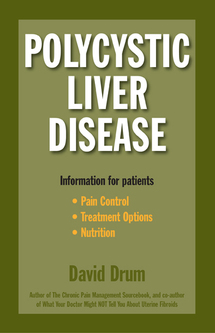EXCERPTS FROM POLYCYSTIC LIVER DISEASE

...from THE PREFACE
When my daughter was diagnosed with polycystic liver disease, I knew very little about it. To my knowledge, neither polycystic liver disease nor its frequent companion, polycystic kidney disease, had occurred in our family before. When my daughter began to experience the very common symptom of pain from an enlarged liver, she asked for my help. As a medical journalist and the author of several health books, I began to learn about what was to me an unfamiliar and somewhat rare disease.
It was not easy to find much basic information for the patient with polycystic liver disease. There was a little information on the internet. Medical journals contained the most reliable data, but this information was scattered over many different publications and written for an audience of sophisticated medical professionals.
Eventually, my daughter was able to make an informed choice on a medical treatment for her pain. Happily, the surgery she chose turned out well. For the benefit of others in my daughter’s situation, I decided to condense the information I found into this short book...Continued in POLYCYSTIC LIVER DISEASE
...from CHAPTER 1
Polycystic liver disease is a rare disease in which multiple cysts form on or inside the liver. According to the National Institute of Health’s Office of Rare Diseases, it affects less than 200,000 people in the United States. The vast majority of people who suffer from polycystic liver disease are women. For a small portion of patients, medical treatments such as surgery may one day become necessary.
Most people with polycystic liver disease are first diagnosed with polycystic kidney disease, one of the most common inherited diseases in the United States and one that affects nearly half a million Americans. Polycystic liver disease was first identified in 1856. From the beginning it was associated with polycystic kidney disease, which manifests in a similar way, as multiple cysts in the kidneys. That polycystic liver disease could occur as a separate disease was only confirmed a century later. When the disease appears without kidney involvement, medical treatments are the same.
In most but not all cases, patients will have cysts on both the kidneys and the liver. According to one study, when polycystic kidney disease is diagnosed, about 30% of those patients also already have polycystic liver disease. By the age of thirty, an estimated 85% of people with polycystic kidney disease will develop cysts on the liver. Generally speaking, people with more advanced polycystic kidney disease also have ... Continued in POLYCYSTIC LIVER DISEASE.
...from Chapter 4
People with polycystic liver disease can experience a number of symptoms associated with the growth of liver cysts, and the increased size of the liver. Symptoms can be acute or sudden. They can also be chronic or long-lasting. Complications such as cyst infection, hemorrhage, and portal vein hypertension are also addressed in this chapter.
The most common acute symptom experienced by people with polycystic liver disease is pain. Pain was reported by almost 37% of patients at diagnosis in a 2005 study. Other reports show pain afflicts as many as 60 percent of patients with an established diagnosis of polycystic kidney disease. Pain can come from the pressure of many cysts, from only a few cysts, or from cysts which press against arteries, veins, or bile ducts. Women who have given birth more than two times more frequently experience acute pain...continued in POLYCYSTIC LIVER DISEASE.
...from Chapter 6
Polycystic liver disease is not life-threatening, but the discomfort of symptoms drives many to seek relief through medical treatment or surgery. Depending on the intensity of symptoms, invasive treatment may be necessary even if the liver is not drastically enlarged. There are five accepted medical treatments for treating liver cysts:
* Aspiration or draining of cysts
* Nonsurgical treatment with sclerosing agents
* Laparoscopic and open fenestration surgery
* Liver resection and fenestration
* Liver transplantation
One method of assessing the severity of polycystic liver disease is Gigot’s classification which is based on computerized tomography (CT) scans. Gigot’s type I classification is less than 10 large cysts, type II is diffuse involvement of the functional portion or parenchyma of the liver with large remaining areas without cysts, and type III is massive diffuse involvement of the liver parenchyma with only a few areas of normal tissue between cysts. Doctors take assessments such as these into account when recommending a procedure. For instance, with type I patients, laparoscopic fenestration may be the first option recommended. With type II, it may be open fenestration. With type III, in symptomatic cases it may be a liver resection or liver transplant...continued in POLYCYSTIC LIVER DISEASE.
Also see, TABLE OF CONTENTS
How to order, CLICK HERE
(c) Burning Books Press